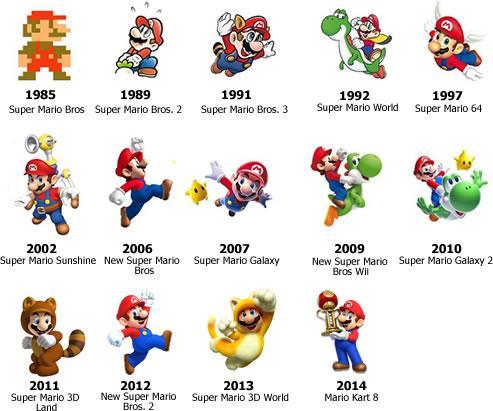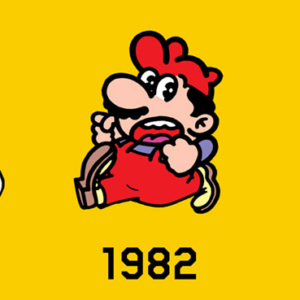The Birth of Jumpman in Japan
The first appearance of Mario was in the arcade game Donkey Kong, released by Nintendo in 1981. He was created by Shigeru Miyamoto, a young game designer who wanted to make a game that featured a love triangle between a gorilla, a carpenter, and a damsel in distress. The game was inspired by the classic movie King Kong, as well as the Popeye cartoons.
The character that would later become Mario was originally called “Jumpman”, because his main ability was to jump over barrels thrown by the gorilla. He had a mustache and dark hair, but no other distinctive features. Miyamoto chose this design because it was easy to draw with the limited pixels available at the time. He also gave him a red cap and overalls, to make his arms and head stand out from the background.
Jumpman was not intended to have any specific nationality or ethnicity. He was just a generic hero who had to rescue his girlfriend, Pauline, from the clutches of the gorilla, Donkey Kong. The game was a huge success in Japan, and soon caught the attention of Nintendo’s American branch, who wanted to distribute it in the US.

The Renaming of Mario in America
When Donkey Kong arrived in America, Nintendo’s American division faced a problem. They thought that Jumpman was a lame name for a hero, and they wanted to give him a more appealing and memorable name. They also wanted to secure the rights to use the name Donkey Kong, which was similar to King Kong, a trademark owned by Universal Studios.
As the story goes, one day, the landlord of Nintendo’s warehouse in Seattle, a man named Mario Segale, came to collect the rent. He was an Italian-American businessman who had a resemblance to Jumpman. The Nintendo staff decided to name the character after him, as a way of paying tribute and avoiding legal troubles. They also changed his occupation from a carpenter to a plumber, to match his blue overalls and red cap.
Thus, Mario was born, and he made his debut in the US version of Donkey Kong, along with his brother Luigi, who was introduced as a second player option in the sequel, Mario Bros. The name Mario was also adopted by Nintendo of Japan, who liked the sound of it and thought it fit the character’s cheerful personality.
The Italianization of Mario in America
Mario’s Italian identity was not very prominent or consistent in his early games. He was still a generic hero who traveled to different worlds and fought various enemies, without much backstory or characterization. He also did not have a voice, except for some grunts and screams.
However, in America, there was a growing interest in giving Mario a more defined and relatable personality and background. This was partly due to the popularity of the Super Mario Bros. game, released in 1985, which established the Mushroom Kingdom as Mario’s main setting and introduced many of his iconic friends and foes, such as Princess Peach, Bowser, Toad, and Yoshi.
In 1989, Nintendo of America produced an animated series based on the Super Mario Bros. game, called The Super Mario Bros. Super Show. The show featured live-action segments, where Mario and Luigi were portrayed by actors Lou Albano and Danny Wells, respectively. They were depicted as working-class Italian-American plumbers living in Brooklyn, who often got transported to the Mushroom Kingdom through a warp pipe. They also had various stereotypical Italian traits and habits, such as eating pasta, pizza, and meatballs, speaking with a thick accent, and using expressions like “mamma mia” and “fuggedaboutit”.
The show was a hit among American children, and it helped to popularize Mario’s Italian identity in the US. It also influenced other media adaptations of Mario, such as comics, books, and movies, which followed the same premise and characterization.
The Voice of Mario in America and Japan
In the early 1990s, Nintendo of America hired an actor named Charles Martinet to be the official voice of Mario for promotional events and merchandise. Martinet had auditioned for the role by improvising a cheerful and friendly voice, with a strong Italian accent. He also created different voices for Luigi, Wario, and Waluigi, Mario’s counterparts and rivals.
Martinet’s voice became the definitive voice of Mario in America, and he soon started to voice him in video games as well, starting with Super Mario 64, released in 1996. This was the first game where Mario spoke, albeit with very few words and phrases, such as “It’s-a me, Mario!”, “Let’s-a go!”, and “Wahoo!”. Martinet also added some personality and emotion to Mario’s voice, making him sound happy, excited, surprised, or scared, depending on the situation.
Interestingly, Nintendo of Japan did not hire a Japanese actor to voice Mario in Japan, and instead used Martinet’s voice as well. This made Mario’s Italian identity more evident and consistent in Japan, as he spoke with the same accent and expressions as in America. However, some Japanese fans also found his voice to be annoying or childish, and preferred the silent or grunting Mario of the previous games.
In the Mario and Luigi RPG series, released in 2003, Mario and Luigi are depicted as speaking Italian to each other, but broken English to other characters, such as Princess Peach or Bowser. This is a humorous and charming way of showing their brotherly bond and their foreignness in the Mushroom Kingdom.
The Conclusion
Mario’s Italian identity is a result of a complex and fascinating process of cultural exchange and adaptation, between Japan and America, and between different media and genres. It is not something that was planned or intended by his original creator, but rather something that evolved organically and spontaneously, through the interactions and influences of different people and contexts.
Mario’s Italian identity is also a source of his appeal and popularity, as it makes him more human and relatable, while also adding some humor and diversity to his character. He is a hero who can transcend boundaries and appeal to different audiences, regardless of their nationality or ethnicity. He is a symbol of fun, adventure, and creativity, and a testament to the power and potential of video games as a medium of expression and communication.


Leave a Reply